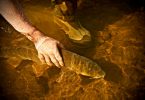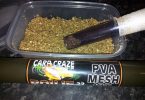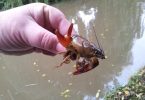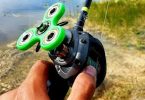Just how much do you know about the line you are using?
About a year ago I took it upon myself to scientifically test 21 different spools of 15lb mono. I’m glad I decided to do this because it really opened my eyes to the huge world of fishing line.
There are so many factors that govern what we perceive to be a ‘good line’, but simply looking or feeling nice isn’t enough when it comes to buying a quality mainline. Here are the results of a very interesting experiment…
HOW IT WAS DONE?
LINEAR BREAKING STRAIN TEST
You may have seen one of the Berkley line testing machines before. It’s a simple, but very expensive piece of equipment used by both line manufacturers and specialist angling groups alike. All light-line records have to pass the test on this type of machine before they can be accepted – so these results are as good as you will get anywhere in the world.
To test a line sample you must first wind one end around a small disc on the measuring end of the machine, and clip it in place (there are no knots used to secure the lines to get a more accurate reading). You then connect the other end of the line in the same manner to a larger disc at the other end of the machine.
When each test begins, the larger wheel rotates at a constant speed until the line snaps. The final poundage is displayed on the measuring device.
Each spool of line was tested three times to get an average. The line samples were also taken from various depths of each spool (rather than taking the first three metres, samples were taken from the beginning and middle of each one.)
LINEAR BREAKING STRAIN TEST RESULTS
|
Brand of Line |
Diameter(mm) | Test 1 (lb) | Test 2 (lb) | Test 3 (lb) | Average (lb) |
| Masterline Yellow | 0.393 | 24.5 | 23.5 | 24 | 24 |
| Masterline Blue | 0.393 | 23 | 23.5 | 23.5 | 23.3 |
| Penn Senator | 0.393 | 21.5 | 24 | 23 | 22.8 |
| Berkley Big Game Inshore | 0.368 | 21.5 | 21 | 21.5 | 21.3 |
| Daiwa Sensor | 0.356 | 21 | 20.5 | 21 | 20.8 |
| Berkley Big Game | 0.386 | 20.5 | 20.5 | 20.5 | 20.5 |
| Shakespeare Omniflex | 0.386 | 20 | 20 | 20 | 20 |
| Sufix Tritanium | 0.343 | 19 | 20 | 19 | 19.3 |
| Daiwa Tournament | 0.330 | 19 | 19 | 18.5 | 18.8 |
| Ultima Tournament | 0.330 | 18.5 | 17 | 19 | 18.1 |
| Shakespeare Superjet | 0.356 | 16.5 | 17 | 16.5 | 16.7 |
| Shimano Baitrunner GT | 0.304 | 17 | 16 | 17 | 16.6 |
| Profish Ghost Line | 0.330 | 16.5 | 16.5 | 16.5 | 16.5 |
| Shakespeare Sigma | 0.393 | 15 | 16 | 15.5 | 15.5 |
| Ultima Seastrike | 0.356 | 15 | 15 | 15 | 15 |
| Ultima Mist Grey | 0.343 | 15 | 14.5 | 14.5 | 14.6 |
| Daiwa Super Shinobi | 0.297 | 14 | 14 | 14 | 14 |
| Mason Bass On | 0.343 | 14 | 14 | 14 | 14 |
| Sylcast Blue | 0.356 | 14 | 14 | 14 | 14 |
| Ultima F1 | 0.304 | 14 | 14 | 14 | 14 |
| Silstar Taktiq | 0.279 | 14 | 13.5 | 14 | 13.8 |
ABRASION TEST
The machine I used for this test belongs to Relum UK. It’s a simple, mechanical device that tests three samples of line at once – again to get an average.
Basically you take three 12-inch lengths of line and attach each one to one of the three arms on the machine. To the ends of each sample you attach a 550-gram (about 1lb 4oz) weight. This allows the middle section of each line to rest over three separate drums of fine grade sandpaper at 45-degrees.
When the machine is activated, the arms move up and down (this counts as one cycle) until all three lines have snapped. Each cycle is recorded on a separate clicker above the respective arm.
It’s a very simple operation, but very effective and accurate as you can see from the results.
Each line was tested simultaneously, just in case there were any irregularities with any of the arms.
The results shocked me, and most of the angling trade!
Abrasion Formula
To obtain the abrasion ratio, each line’s average cycles was divided by its diameter.
ABRASION TEST RESULTS
| Brand of Line |
Test 1 |
Test 2 |
Test 3 |
Average |
Ratio |
| Profish Ghost Line | 1444 | 2494 | 2935 | 2291 | 6942 |
| Sufix Tritanium | 313 | 388 | 707 | 469.3 | 1368 |
| Penn Senator | 147 | 158 | 174 | 159.7 | 406 |
| Masterline Blue | 72 | 98 | 135 | 101.7 | 259 |
| Daiwa Tournament | 79 | 80 | 92 | 83.7 | 254 |
| Masterline Yellow | 85 | 90 | 111 | 95.3 | 242 |
| Berkley Big Game | 65 | 79 | 85 | 76.3 | 207 |
| Ultima Mist Grey | 58 | 63 | 77 | 66 | 192 |
| Daiwa Sensor | 61 | 68 | 74 | 67.7 | 190 |
| Berkley Big Game Inshore | 65 | 70 | 73 | 69.3 | 188 |
| Sylcast Blue | 56 | 58 | 75 | 63 | 177 |
| Shakespeare Omniflex | 61 | 63 | 70 | 64.7 | 176 |
| Daiwa Super Shinobi | 39 | 40 | 63 | 47.3 | 170 |
| Shakespeare Sigma | 67 | 67 | 67 | 67 | 170 |
| Shakespeare Superjet | 55 | 58 | 58 | 57 | 160 |
| Ultima Seastrike | 47 | 59 | 64 | 56.7 | 159 |
| Mason Bass On | 50 | 50 | 57 | 52.3 | 152 |
| Ultima Tournament | 44 | 50 | 57 | 50.3 | 152 |
| Shimano Baitrunner GT | 37 | 41 | 51 | 43 | 141 |
| Ultima F1 | 38 | 40 | 43 | 40.3 | 133 |
| Silstar Taktiq | 27 | 32 | 46 | 35 | 125 |
CONCLUSION
Remember that all these lines have a stated breaking strain of 15lb.
1. The most consistent line was Ultima Seastrike, which broke at 15lb every time I tested it.
2. The highest average breaking strain was Masterline Yellow at 24lb.
3. The lowest average breaking strain was Silstar Taktiq at 13.8lb.
4. The highest diameter was shared by Shakespeare sigma, Masterline Blue and Yeloow, Penn Senator – all averaging 0.393mm
5. The lowest diameter was shared by Silstar Taktiq and Daiwa Super Shinobi.
6. The best diameter to abrasion resistance ratio was Profish Ghostline, followed by Sufix Tritanium.
7. The lowest abrasion resistance ratio was Silstar Taktiq.
Dave Barham







